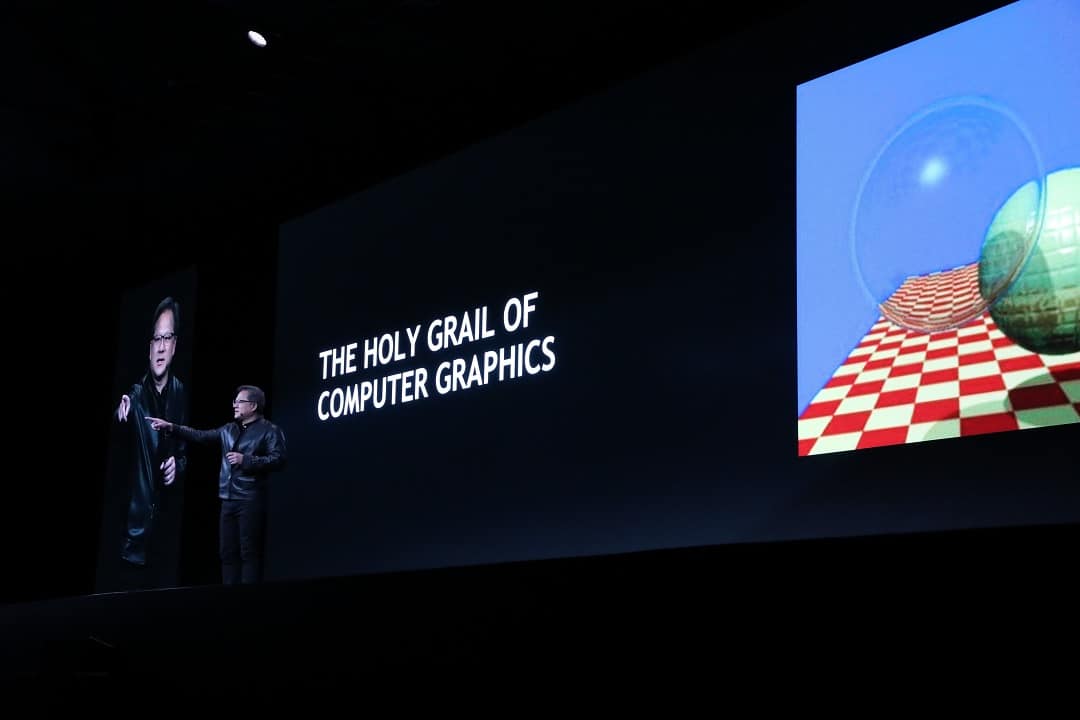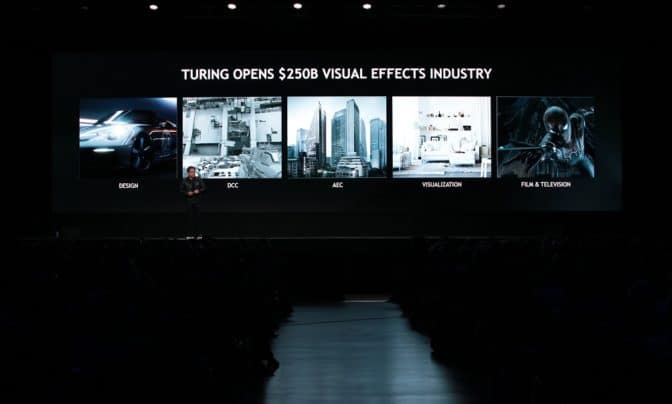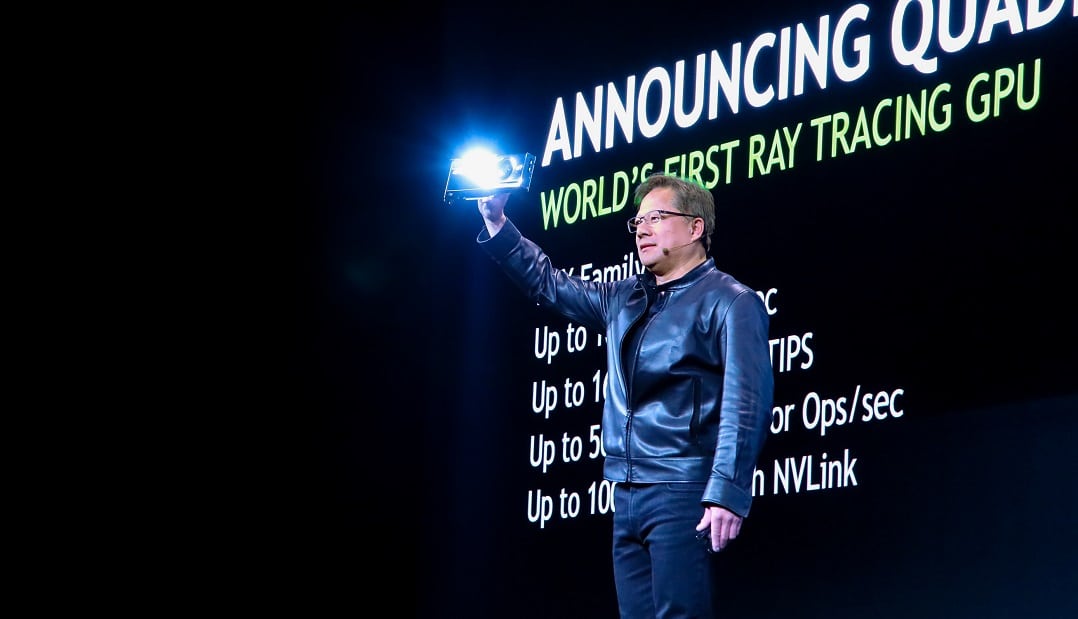Ray-traced graphics offer incredible realism. Interactive graphics driven by GPUs offer speed and responsiveness. The two now come together in the greatest leap since the invention of the CUDA GPU in 2006, NVIDIA CEO Jensen Huang announced Monday.
Speaking at the SIGGRAPH professional graphics conference in Vancouver, Huang unveiled Turing, NVIDIA’s eighth-generation GPU architecture, bringing ray tracing to real-time graphics. He also introduced the first Turing-based GPUs — the NVIDIA Quadro RTX 8000, Quadro RTX 6000 and Quadro RTX 5000. And he detailed the Quadro RTX Server, a reference architecture for the $250 billion visual effects industry.
“This fundamentally changes how computer graphics will be done, it’s a step change in realism,” Huang told an audience of more than 1,200 graphics pros gathered at the sleek glass and steel Vancouver Convention Center, which sits across a waterway criss-crossed by cruise ships and seaplanes from the stunning North Shore mountains.
Dell EMC, HP, Inc., Hewlett Packard Enterprise, Lenovo, Fujitsu, Boxx and SuperMicro will be among the system vendors supporting the latest line of Quadro processors, he said. The three new Quadro GPUs will be available starting in the fourth quarter.
New Silicon, New Software
Turing — the result of more than 10,000 engineering-years of effort — features new RT Cores to accelerate ray tracing and new Tensor Cores for AI inferencing. Together for the first time, Huang explained, they make real-time ray tracing possible.
“It has to be amazing at today’s applications, but utterly awesome at tomorrow’s,” Huang said.
That new silicon is being supported by software from more than two dozen key ISVs. To help developers quickly take full advantage of Turing’s capabilities, NVIDIA has enhanced its RTX development platform with new AI, ray-tracing and simulation SDKs to speed Turing’s capabilities to key graphics applications addressing millions of designers, artists and scientists.
Huang also announced that NVIDIA is open sourcing its Material Definition Language software development kit, starting today.
“We now have a brand new software stack for computer graphics merging rastering and ray tracing, computing and AI,” Huang said.
Bringing Ray Tracing to Real Time
To put Turing’s capabilities into perspective, Huang opened his keynote talk with a video telling the visual history of computer graphics over the past decades narrated by its pioneering figures — many of whom sat in the audience as the video played. It’s the tale of a grand quest to simulate the world we see all around us, one that has captivated some of the world’s brightest minds for decades.

Turing’s dedicated ray-tracing processors — called RT Cores — accelerate the computation of how light and sound travel in 3D environments. Turing accelerates real-time ray tracing operations by 25x over the previous Pascal generation. It can be used for final-frame rendering for film effects at more than 30x the speed of CPUs.
A Familiar Demo, Accelerated by a New GPU
To demonstrate this, Huang showed the audience a demo they’d seen — Epic Games’ stunning Star Wars-themed Reflections ray-tracing demo — running on hardware they hadn’t. At the Game Developers Conference in March, Reflections ran on a $70,000 DGX Station equipped with four Volta GPUs. This time the demo ran on a single Turing GPU.
“It turns out it was running on this — one single GPU,” Huang said to wild applause as he playfully blinded the camera by angling the gleaming Quadro RTX 8000’s reflective outer shroud. “This is the world’s first ray-tracing GPU.”
An AI for Beauty
At the same time, the Turing architecture’s Tensor Cores — processors that accelerate deep learning training and inferencing — provide up to 500 trillion tensor operations a second. This, in turn, powers AI-enhanced features — such as denoising, resolution scaling and video re-timing — included in the NVIDIA NGX software development kit.
“At some point you can use AI or some heuristics to figure out what are the missing dots and how should we fill it all in, and it allows us to complete the frame a lot faster than we otherwise could,” Huang said, describing the new deep learning-powered technology stack that enables developers to integrate accelerated, enhanced graphics, photo imaging and video processing into applications with pre-trained networks.
“Nothing is more powerful than using deep learning to do that,” Huang said.
Raster, Faster
Turing also cranks through rasterization — the mainstay of interactive graphics — 6x faster than Pascal, Huang said, detailing how technologies such as variable-rate shading, texture-space shading and multi-view rendering will provide for more fluid interactivity with large models and scenes and improved VR experiences.
Turning to a tested graphics teaching tool, Huang told the story of how visual effects have progressed by using the Cornell Box — a 3D box inside which various objects are displayed. Huang showed off how Turing uses ray tracing to deliver complex effects — ranging from diffused reflection to refractions to caustics to global illumination — with stunning photorealism.
Another showstopper: Huang showed off a video featuring a Porsche concept car — illuminated by lights that played across its undulating curves — celebrating the automaker’s 70th anniversary. While the photoreal demo looks filmed, it’s entirely generated on a Turing GPU running Epic Games’ Unreal Engine. “For the very first time, NVIDIA RTX is making it possible for us to bring accelerated workflows and acceleration to this market,” Huang said.
Creators looking to tackle such projects will have plenty of tools to choose from. In addition to three powerful Turing-powered graphics cards — the $2,300 Quadro RTX 5000, $6,300 Quadro RTX 6000 and $10,000 Quadro RTX 8000 — Huang also introduced the Quadro RTX Server.

Equipped with eight Turing GPUs, it’s designed to slash rendering times from hours to minutes. Four 8-GPU RTX Servers can do the rendering work of 240 dual-core servers at 1/4th the cost, using 1/10 the space and consuming 1/11th the power. “Instead of a shot taking five hours or six hours, it now takes just one hour,” Huang said. “It’s going to completely change how people do film.”
Summing up, Huang described Turing as the “world’s first ray-tracing GPU” and “the single greatest leap that we have ever made in one generation.”
A Rousing Cybernetic Strut
Huang ended his talk with a demo that had members of the audience dancing their way out the door. Dubbed Sol, it showed a pair of robotic assistants placing glossy-white space-age armor onto a lone figure, each piece finding its place with a satisfying click.
As the protagonist ascends to a hatch — with ray-traced reflections of the futuristic environment all around him gleaming from his suit and visor — the now unsupervised robots begin to dance to the immortal, brass-backed, 16-bar blues chord progression of 1977’s “Boogie Shoes” by KC and the Sunshine Band.
Hearing the music, the armored figure returns, cocks his head in surprise and — to the audience’s delight — demonstrates his own fluid, loose-limbed dance moves.
As the screen fades to black, and then to an image of the new Quadro RTX GPU, the music continues to pump. The message is clear: now it’s your turn to take what you’ve seen and dance.
